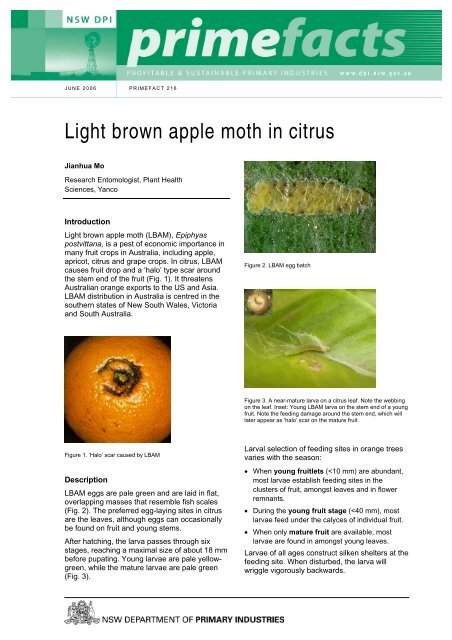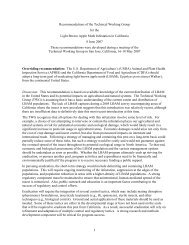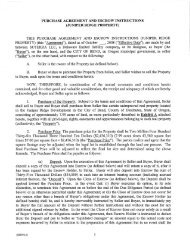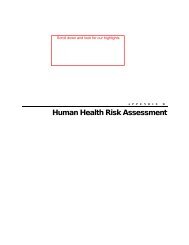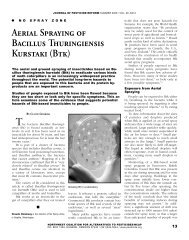Light brown apple moth in citrus - NSW Department of Primary ...
Light brown apple moth in citrus - NSW Department of Primary ...
Light brown apple moth in citrus - NSW Department of Primary ...
You also want an ePaper? Increase the reach of your titles
YUMPU automatically turns print PDFs into web optimized ePapers that Google loves.
JUNE 2006 PRIMEFACT 216<br />
<strong>Light</strong> <strong>brown</strong> <strong>apple</strong> <strong>moth</strong> <strong>in</strong> <strong>citrus</strong><br />
Jianhua Mo<br />
Research Entomologist, Plant Health<br />
Sciences, Yanco<br />
Introduction<br />
<strong>Light</strong> <strong>brown</strong> <strong>apple</strong> <strong>moth</strong> (LBAM), Epiphyas<br />
postvittana, is a pest <strong>of</strong> economic importance <strong>in</strong><br />
many fruit crops <strong>in</strong> Australia, <strong>in</strong>clud<strong>in</strong>g <strong>apple</strong>,<br />
apricot, <strong>citrus</strong> and grape crops. In <strong>citrus</strong>, LBAM<br />
causes fruit drop and a ‘halo’ type scar around<br />
the stem end <strong>of</strong> the fruit (Fig. 1). It threatens<br />
Australian orange exports to the US and Asia.<br />
LBAM distribution <strong>in</strong> Australia is centred <strong>in</strong> the<br />
southern states <strong>of</strong> New South Wales, Victoria<br />
and South Australia.<br />
Figure 2. LBAM egg batch<br />
Figure 3. A near-mature larva on a <strong>citrus</strong> leaf. Note the webb<strong>in</strong>g<br />
on the leaf. Inset: Young LBAM larva on the stem end <strong>of</strong> a young<br />
fruit. Note the feed<strong>in</strong>g damage around the stem end, which will<br />
later appear as ‘halo’ scar on the mature fruit.<br />
Figure 1. ‘Halo’ scar caused by LBAM<br />
Description<br />
LBAM eggs are pale green and are laid <strong>in</strong> flat,<br />
overlapp<strong>in</strong>g masses that resemble fish scales<br />
(Fig. 2). The preferred egg-lay<strong>in</strong>g sites <strong>in</strong> <strong>citrus</strong><br />
are the leaves, although eggs can occasionally<br />
be found on fruit and young stems.<br />
After hatch<strong>in</strong>g, the larva passes through six<br />
stages, reach<strong>in</strong>g a maximal size <strong>of</strong> about 18 mm<br />
before pupat<strong>in</strong>g. Young larvae are pale yellowgreen,<br />
while the mature larvae are pale green<br />
(Fig. 3).<br />
Larval selection <strong>of</strong> feed<strong>in</strong>g sites <strong>in</strong> orange trees<br />
varies with the season:<br />
• When young fruitlets (
Pupation takes place <strong>in</strong>side the silken feed<strong>in</strong>g<br />
shelters. Pupae are red-<strong>brown</strong> and 10–12 mm<br />
long (Fig. 4).<br />
orange trees requires a m<strong>in</strong>imum <strong>of</strong> 776 degreedays<br />
above 7.5°C. In the southern <strong>citrus</strong> region<br />
<strong>of</strong> Australia, this equates to four or five<br />
generations per year. An onl<strong>in</strong>e LBAM<br />
development calculator 1 is available to help with<br />
the estimation <strong>of</strong> development durations for all<br />
LBAM stages at given temperature ranges.<br />
Figure 4. LBAM pupa<br />
Adults are light <strong>brown</strong> and appear bell-shaped.<br />
Female <strong>moth</strong>s have a w<strong>in</strong>gspan <strong>of</strong> about 18 mm,<br />
but male <strong>moth</strong>s are much smaller. Female <strong>moth</strong>s<br />
can also be dist<strong>in</strong>guished by the presence <strong>of</strong> a<br />
dark spot <strong>in</strong> the centre-front <strong>of</strong> the folded w<strong>in</strong>gs.<br />
Males have a dark band across their folded<br />
w<strong>in</strong>gs (Fig. 5).<br />
Seasonal patterns<br />
Seasonal patterns <strong>of</strong> LBAM populations <strong>in</strong><br />
southern <strong>citrus</strong> regions <strong>of</strong> Australia are<br />
characterised by the presence <strong>of</strong> summer<br />
troughs (Fig. 6). Depend<strong>in</strong>g on the year, the<br />
troughs start between late November and late<br />
January, and end <strong>in</strong> April. They correspond to<br />
periods <strong>of</strong> high temperature.<br />
Annual LBAM peaks can occur <strong>in</strong> other months.<br />
While spr<strong>in</strong>g peaks may be enhanced by the<br />
prevalence <strong>of</strong> young fruit and leaves, w<strong>in</strong>ter<br />
peaks may be a result <strong>of</strong> migration <strong>of</strong> adult<br />
<strong>moth</strong>s from adjacent v<strong>in</strong>eyards follow<strong>in</strong>g grape<br />
harvest <strong>in</strong> late autumn.<br />
Avg catch/trap/week<br />
20<br />
18<br />
16<br />
14<br />
12<br />
10<br />
8<br />
6<br />
4<br />
2<br />
0<br />
2001-2002 2002-2003 2003-2004<br />
Jul-04<br />
May-04<br />
Mar-04<br />
Jan-04<br />
Dec-03<br />
Oct-03<br />
Aug-03<br />
Jun-03<br />
Apr-03<br />
Feb-03<br />
Dec-02<br />
Oct-02<br />
Aug-02<br />
Jun-02<br />
Apr-02<br />
Feb-02<br />
Dec-01<br />
Oct-01<br />
Aug-01<br />
40<br />
35<br />
30<br />
25<br />
20<br />
15<br />
10<br />
5<br />
0<br />
Avg max. temp (°C)<br />
Figure 6. Weekly catches (shown by the solid l<strong>in</strong>es <strong>in</strong> the graph)<br />
<strong>of</strong> LBAM females from pheromone traps <strong>in</strong> <strong>citrus</strong> orchard <strong>in</strong> the<br />
River<strong>in</strong>a dur<strong>in</strong>g the period August 2001 to July 2004. Dotted l<strong>in</strong>es<br />
show the average maximum daily temperature.<br />
Figure 5. LBAM adults: male (left) and female (right)<br />
Development and survival<br />
LBAM is able to complete its lifecycle by feed<strong>in</strong>g<br />
exclusively on young orange leaves, mature<br />
orange leaves, young orange fruit or mature<br />
orange fruit. However, <strong>citrus</strong> trees do not appear<br />
to be the optimal hosts <strong>of</strong> LBAM. Survival rate <strong>of</strong><br />
LBAM from egg to adult <strong>in</strong> orange trees is less<br />
than 20% and is generally higher on young<br />
leaves and young fruit than on other tissues.<br />
Most mortality occurs as a result <strong>of</strong> failure to<br />
establish suitable feed<strong>in</strong>g sites soon after<br />
hatch<strong>in</strong>g.<br />
LBAM development on orange leaves and fruit is<br />
slower than on <strong>apple</strong> and other favourable hosts<br />
<strong>of</strong> LBAM. Completion <strong>of</strong> the entire lifecycle <strong>in</strong><br />
Monitor<strong>in</strong>g<br />
Pheromone traps can be used to <strong>in</strong>dicate the<br />
tim<strong>in</strong>g <strong>of</strong> high LBAM <strong>moth</strong> activity, which <strong>in</strong> turn<br />
can be used to predict the tim<strong>in</strong>g <strong>of</strong> high LBAM<br />
larvae numbers. A m<strong>in</strong>imum <strong>of</strong> four traps should<br />
be placed <strong>in</strong> each monitor<strong>in</strong>g block. The traps<br />
should be monitored weekly from September to<br />
December and aga<strong>in</strong> from May to August.<br />
Follow<strong>in</strong>g the detection <strong>of</strong> local population<br />
peaks, trees should be <strong>in</strong>spected for LBAM eggs<br />
and larvae:<br />
• For <strong>in</strong>spection <strong>of</strong> trees that have an abundance<br />
<strong>of</strong> young fruit, four fruit-bear<strong>in</strong>g branch<br />
term<strong>in</strong>als from each <strong>of</strong> 20 randomly selected<br />
1<br />
www.agric.nsw.gov.au/ reader/<strong>citrus</strong>-pests-diseases/citlbamcalc.htm<br />
PRIMEFACT 216, LIGHT BROWN APPLE MOTH IN CITRUS 2
trees <strong>in</strong> each block should be checked. Webbed<br />
clusters <strong>of</strong> young fruitlets, flowers and leaves,<br />
and the calyces <strong>of</strong> <strong>in</strong>dividual fruit, should be<br />
opened to check for LBAM larvae.<br />
• For <strong>in</strong>spection <strong>of</strong> trees with predom<strong>in</strong>antly<br />
mature fruit, check 10 fruit from each <strong>of</strong> 20<br />
randomly selected trees <strong>in</strong> each block. Touch<strong>in</strong>g<br />
fruit and leaves should be separated, and any<br />
bor<strong>in</strong>g holes on the fruit should be opened to<br />
check for the presence <strong>of</strong> LBAM larvae. Webbed<br />
young leaves, when sighted, should also be<br />
<strong>in</strong>spected. Also look for white to pale-green<br />
overlapp<strong>in</strong>g masses <strong>of</strong> LBAM eggs on leaves.<br />
When pheromone traps are not used, regular<br />
orchard <strong>in</strong>spections are strongly recommended.<br />
If labour permits, this should be done fortnightly<br />
from September to December for young fruit,<br />
and from May to November for mature fruit.<br />
If a <strong>citrus</strong> farm which is grow<strong>in</strong>g export oranges<br />
is located next to a v<strong>in</strong>eyard, orchard <strong>in</strong>spection<br />
is especially important follow<strong>in</strong>g grape harvest,<br />
as there may be a large <strong>in</strong>flux <strong>of</strong> LBAM from the<br />
v<strong>in</strong>eyard to the <strong>citrus</strong> blocks.<br />
Management<br />
Natural enemies<br />
LBAM populations <strong>in</strong> <strong>citrus</strong> orchards are<br />
normally kept at low levels by a comb<strong>in</strong>ation <strong>of</strong><br />
biological and environmental factors. Chemical<br />
<strong>in</strong>tervention is <strong>of</strong>ten not needed. Biological<br />
factors <strong>in</strong>clude the relatively low suitability <strong>of</strong><br />
<strong>citrus</strong> trees to the development and survival <strong>of</strong><br />
LBAM, and the natural enemies <strong>of</strong> the <strong>in</strong>sect.<br />
• Natural enemies <strong>of</strong> the eggs <strong>in</strong>clude the t<strong>in</strong>y<br />
parasitic Trichogramma wasps.<br />
• Natural enemies <strong>of</strong> the larvae <strong>in</strong>clude:<br />
o parasitic wasps Dolichogenidea arisanus<br />
and Xanthopimpla spp.;<br />
o parasitic flies Goniozus spp. and<br />
Zosteromyia spp.;<br />
o predatory bug Ochalia shellembergii;<br />
o lacew<strong>in</strong>gs;<br />
o spiders;<br />
o various pathogens.<br />
Spiders are abundant <strong>in</strong> <strong>citrus</strong> orchards and may<br />
play an important role <strong>in</strong> regulat<strong>in</strong>g LBAM<br />
populations.<br />
Mat<strong>in</strong>g disruption<br />
Mat<strong>in</strong>g disruption is an effective technique for<br />
manag<strong>in</strong>g LBAM <strong>in</strong> <strong>citrus</strong>. By flood<strong>in</strong>g the target<br />
area with synthetic copies <strong>of</strong> the female sex<br />
pheromone (via ‘mat<strong>in</strong>g disruption dispensers’),<br />
the success rate <strong>of</strong> males <strong>in</strong> f<strong>in</strong>d<strong>in</strong>g local<br />
females is greatly reduced. This results <strong>in</strong><br />
females produc<strong>in</strong>g lower numbers <strong>of</strong> viable<br />
eggs, which leads to a reduction <strong>in</strong> local<br />
populations.<br />
For the technique to be effective, as large an<br />
area as possible should be treated, with no<br />
untreated pockets rema<strong>in</strong><strong>in</strong>g <strong>in</strong>side the area. For<br />
protection aga<strong>in</strong>st feed<strong>in</strong>g damage to young fruit,<br />
mat<strong>in</strong>g disruption dispensers should be put out<br />
<strong>in</strong> August. Mat<strong>in</strong>g disruption dispensers LBAM<br />
Plus® will usually rema<strong>in</strong> effective until February<br />
the follow<strong>in</strong>g year.<br />
For protection <strong>of</strong> export oranges, a second<br />
application <strong>of</strong> the dispensers may be needed <strong>in</strong><br />
early autumn.<br />
Chemical control<br />
If orchard <strong>in</strong>spection <strong>in</strong>dicates an unacceptable<br />
level <strong>of</strong> LBAM eggs and larvae, s<strong>of</strong>t chemicals<br />
may be used. Currently one biological<br />
<strong>in</strong>secticide, Mimic®, is registered for LBAM<br />
control <strong>in</strong> <strong>citrus</strong>. Mimic® is a growth regulator<br />
and has m<strong>in</strong>imal impact on beneficial <strong>in</strong>sects. It<br />
is best used to target young larvae.<br />
Cultural practices<br />
Fallen fruit and broadleaf weeds may also<br />
harbour LBAM. Remov<strong>in</strong>g these from the<br />
orchard will help reduce LBAM populations.<br />
Th<strong>in</strong>n<strong>in</strong>g fruit also helps control <strong>of</strong> LBAM by<br />
reduc<strong>in</strong>g potential feed<strong>in</strong>g sites and leaf-to-fruit<br />
and fruit-to-fruit contact. S<strong>in</strong>ce LBAM larvae<br />
prefer young foliage, practices that reduce the<br />
amount <strong>of</strong> autumn flush on trees are also<br />
beneficial.<br />
References<br />
Mo, J 2004, Development <strong>of</strong> IPM strategies to<br />
manage light<strong>brown</strong> <strong>apple</strong> <strong>moth</strong> <strong>in</strong> <strong>citrus</strong>,<br />
Horticulture Australia Ltd, Sydney.<br />
Mo J, Glover M, Munro S and Beattie GAC 2006,<br />
‘Development <strong>of</strong> Epiphyas postvittana<br />
(Walker) (Lepidoptera: Tortricidae) on leaves<br />
and fruit <strong>of</strong> orange trees’, Journal <strong>of</strong><br />
Economic Entomology, 99: 1321–6.<br />
Mo J, Glover M, Munro S and Beattie GAC 2006,<br />
‘Evaluation <strong>of</strong> mat<strong>in</strong>g disruption for control <strong>of</strong><br />
light<strong>brown</strong> <strong>apple</strong> <strong>moth</strong> (Lepidoptera:<br />
Tortricidae) <strong>in</strong> <strong>citrus</strong>’, Journal <strong>of</strong> Economic<br />
Entomology, 99: 421–6.<br />
Smith D, Beattie GAC and Broadley R (Eds)<br />
1997, Citrus pests and their natural<br />
enemies—<strong>in</strong>tegrated pest management <strong>in</strong><br />
Australia, Queensland <strong>Department</strong> <strong>of</strong> <strong>Primary</strong><br />
Industries, Brisbane.<br />
PRIMEFACT 216, LIGHT BROWN APPLE MOTH IN CITRUS 3
Acknowledgments<br />
Michelle Glover and Scott Munro provided<br />
technical assistance to the research project on<br />
which this publication is based. The research<br />
project was funded by Australian Citrus Industry<br />
and Horticulture Australia Ltd. Sandra Hardy<br />
edited the publication.<br />
Published by <strong>NSW</strong> <strong>Department</strong> <strong>of</strong> <strong>Primary</strong> Industries<br />
© State <strong>of</strong> New South Wales 2006<br />
ISSN 1832-6668<br />
Job number 6700<br />
Updates <strong>of</strong> this Primefact are available at<br />
www.dpi.nsw.gov.au/primefacts<br />
Disclaimer: The <strong>in</strong>formation conta<strong>in</strong>ed <strong>in</strong> this publication is<br />
based on knowledge and understand<strong>in</strong>g at the time <strong>of</strong><br />
writ<strong>in</strong>g (June 2006). However, because <strong>of</strong> advances <strong>in</strong><br />
knowledge, users are rem<strong>in</strong>ded <strong>of</strong> the need to ensure that<br />
<strong>in</strong>formation upon which they rely is up to date and to check<br />
currency <strong>of</strong> the <strong>in</strong>formation with the appropriate <strong>of</strong>ficer <strong>of</strong><br />
New South Wales <strong>Department</strong> <strong>of</strong> <strong>Primary</strong> Industries or the<br />
user’s <strong>in</strong>dependent adviser.<br />
The product trade names <strong>in</strong> this publication are supplied<br />
on the understand<strong>in</strong>g that no preference between<br />
equivalent products is <strong>in</strong>tended and that the <strong>in</strong>clusion <strong>of</strong> a<br />
product name does not imply endorsement by <strong>NSW</strong><br />
<strong>Department</strong> <strong>of</strong> <strong>Primary</strong> Industries over any equivalent<br />
product from another manufacturer.<br />
PRIMEFACT 216, LIGHT BROWN APPLE MOTH IN CITRUS 4


